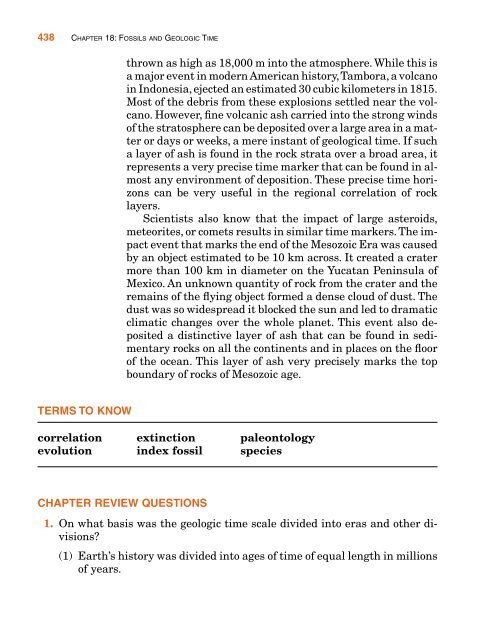Chapter 18 Fossils and Geologic Time
Chapter 18 Fossils and Geologic Time
Chapter 18 Fossils and Geologic Time
Create successful ePaper yourself
Turn your PDF publications into a flip-book with our unique Google optimized e-Paper software.
438 CHAPTER <strong>18</strong>: FOSSILS AND GEOLOGIC TIME<br />
TERMS TO KNOW<br />
thrown as high as <strong>18</strong>,000 m into the atmosphere. While this is<br />
a major event in modern American history,Tambora, a volcano<br />
in Indonesia, ejected an estimated 30 cubic kilometers in <strong>18</strong>15.<br />
Most of the debris from these explosions settled near the volcano.<br />
However, fine volcanic ash carried into the strong winds<br />
of the stratosphere can be deposited over a large area in a matter<br />
or days or weeks, a mere instant of geological time. If such<br />
a layer of ash is found in the rock strata over a broad area, it<br />
represents a very precise time marker that can be found in almost<br />
any environment of deposition. These precise time horizons<br />
can be very useful in the regional correlation of rock<br />
layers.<br />
Scientists also know that the impact of large asteroids,<br />
meteorites, or comets results in similar time markers. The impact<br />
event that marks the end of the Mesozoic Era was caused<br />
by an object estimated to be 10 km across. It created a crater<br />
more than 100 km in diameter on the Yucatan Peninsula of<br />
Mexico. An unknown quantity of rock from the crater <strong>and</strong> the<br />
remains of the flying object formed a dense cloud of dust. The<br />
dust was so widespread it blocked the sun <strong>and</strong> led to dramatic<br />
climatic changes over the whole planet. This event also deposited<br />
a distinctive layer of ash that can be found in sedimentary<br />
rocks on all the continents <strong>and</strong> in places on the floor<br />
of the ocean. This layer of ash very precisely marks the top<br />
boundary of rocks of Mesozoic age.<br />
correlation extinction paleontology<br />
evolution index fossil species<br />
CHAPTER REVIEW QUESTIONS<br />
1. On what basis was the geologic time scale divided into eras <strong>and</strong> other divisions?<br />
(1) Earth’s history was divided into ages of time of equal length in millions<br />
of years.

















